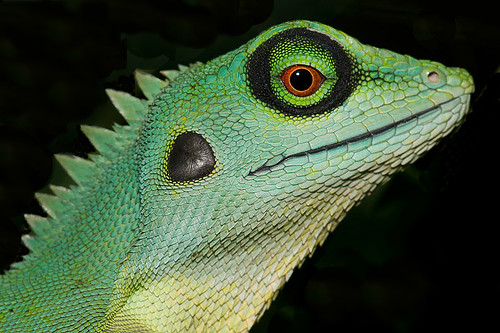
(Photo by sayhitoant)
As mentioned in yesterday's post, Singapore is home to a number of agamid lizards (F. Agamidae). This post will discuss the several species of agamids that are found here.
All our local agamids are members of the subfamily Draconinae, and are generally arboreal insectivores, meaning they spend most of their time in trees and feed on insects. They are in turn hunted by a number of other predators, including birds and snakes.
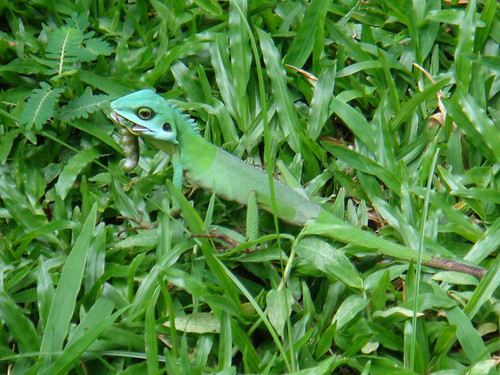
(Photo by Chua Shuyi, from Habitatnews)
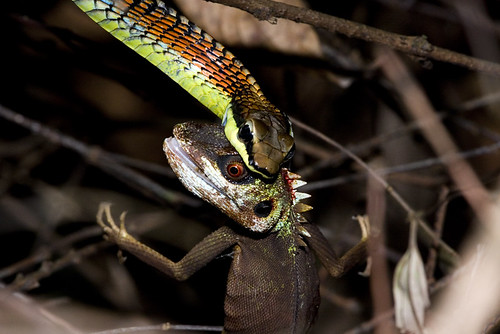
(Photo by Marcus)
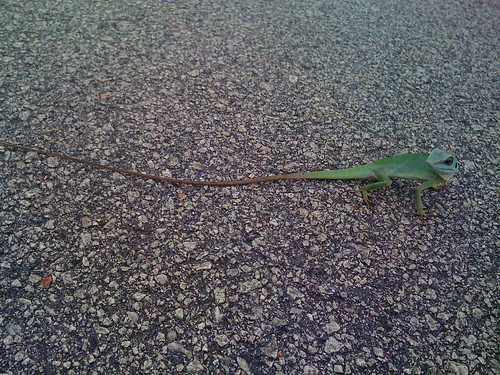
Small to medium-sized lizards, they range in size from 20 to 50 centimetres in total length, although a great deal of that is taken up by the long tail. Unlike other lizard families, the tail is not shed as a defense tactic in most agamids, and amputation of any portion of the tail is permanent.
The most abundant and most commonly encountered agamid in Singapore is the changeable lizard (Calotes versicolor).

(Photo by Jacqueline)
This is the lizard we often find perched on trees and fences in the neighbourhood, clambering about bushes and shrubs in the garden, and even basking along the road. It prefers somewhat open habitats, and has adapted very well to the mixture of urban vegetation, secondary scrub and woodlands so prevalent throughout Singapore.
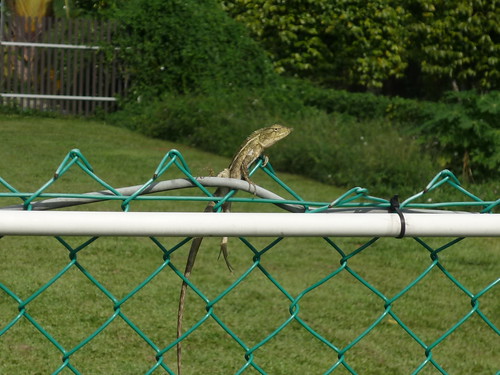
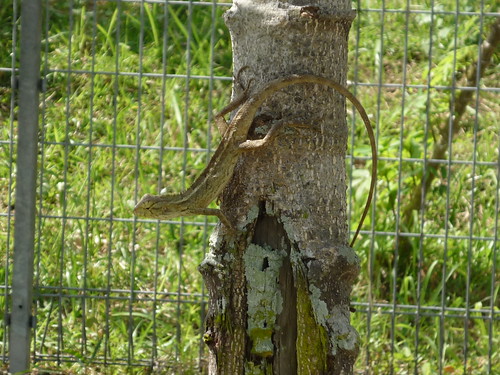
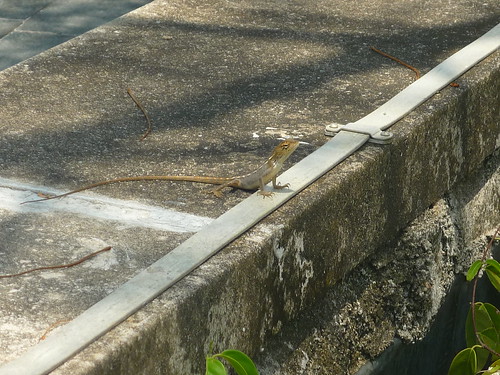
Distributed across a large area of mainland tropical Asia, from India to the Malay Peninsula, morphological and genetic differences between populations in different geographical areas strongly suggest that the changeable lizard actually consists of a complex of several closely-related species.

(Photo by Ria)
Some people mistakenly call this and other agamid lizards 'chameleons', due to their ability to change colour. This is an error, as the true chameleons (F. Chameleonidae) are an entirely different family of lizards (albeit one that's closely related to the agamids), and are not found in Southeast Asia.

Indian chameleon (Chamaeleo zeylanicus);
(Photo by Vishal Pd)
Like the chameleons, the changeable lizard can change its colour either to express its mood, or to improve its camouflage and blend in with its surroundings.

(Photo by y_leong23)
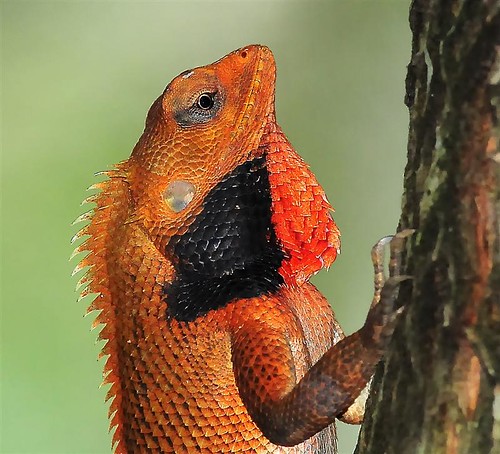
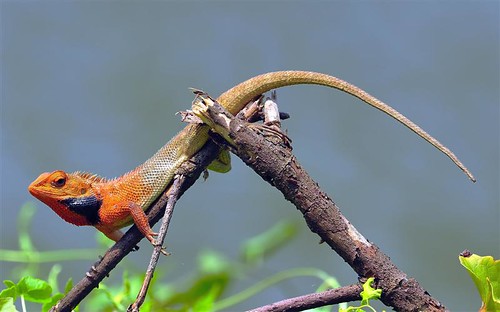
(Photos by NatureInYourBackyard)
During the breeding season, the head and neck of the adult male turns a bright orange or red, and he can often be seen in conspicuous locations, such as on tree branches or bollards, doing push-ups to display his strength and vitality to attract females as well as warn rival males.
The bright red coloration of the head in male changeable lizards has led to them earning the nickname of 'bloodsucker'.
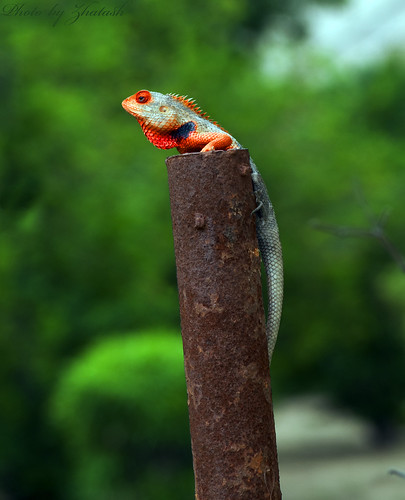
Male in breeding coloration, Pakistan;
(Photo by zhatash)
The changeable lizard is actually not a native species; it was not recorded here before the 1980s, and the southern limit of its range was the northern states of Peninsular Malaysia, such as Perlis and Kedah. It began appearing here only in the 1980s, possibly through stowaways on vehicles and trains arriving from Thailand and northern Peninsular Malaysia. Eventually, enough individuals must have arrived to facilitate the establishment of locally breeding populations. Since then, it has colonised virtually all of mainland Singapore, from urban parks to secondary scrub, as well as many of our offshore islands such as Pulau Ubin, Pulau Tekong, Sentosa, and Pulau Semakau. The changeable lizard has also managed to make its way back across the causeway and establish itself in the southern states of Peninsular Malaysia, where it was formerly absent.
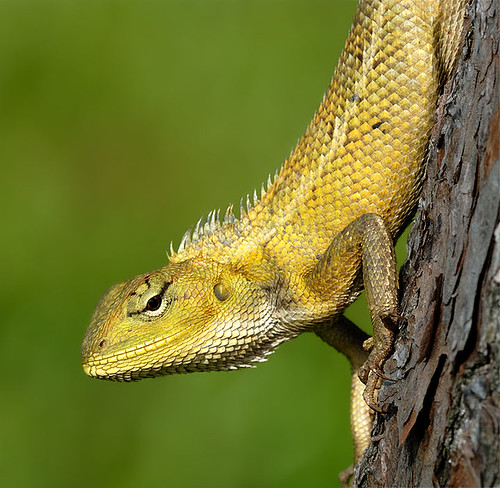
(Photo by y_leong23)
The changeable lizard's addition to our local herpetofauna here is likely to have had a significant impact on one of our native agamids, the green crested lizard (Bronchocoela cristatella).
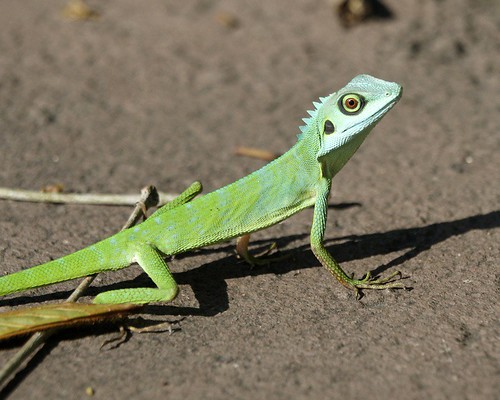
(Photo by Lip Kee)
Formerly the most common lizard found in parks, gardens, and forests, this species appears to have declined at around the same period of time the changeable lizard began to spread around Singapore. It is likely that there is some form of competition over resources between the native green crested lizard and the non-native changeable lizard, a struggle that the changeable lizard appears to have won quite decisively.
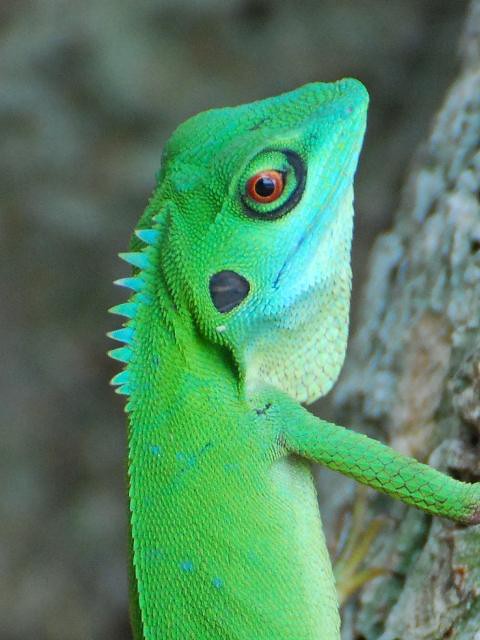
(Photo by kokhuitan)
Today, the green crested lizard can still be encountered in gardens, parks, and secondary scrub all over Singapore, though it is much less common compared to the changeable lizard. The green-crested lizard's stronghold is in the primary and mature secondary rainforests, which its introduced relative avoids for some reason.
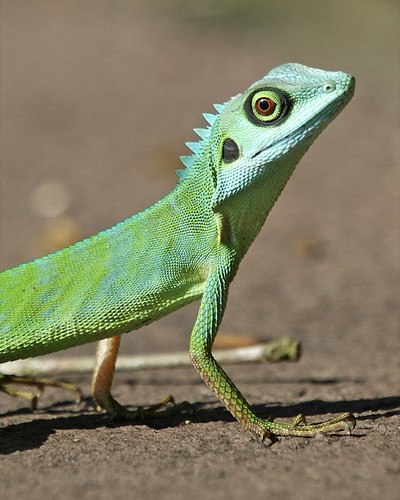
(Photo by Lip Kee)
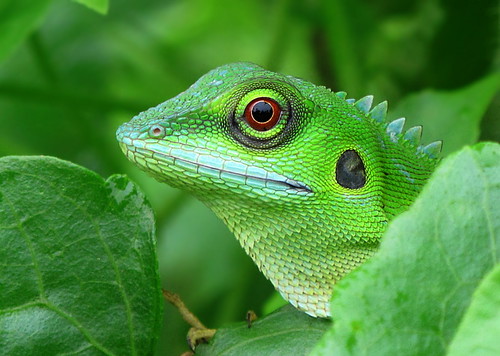
(Photo by Tiomanese)
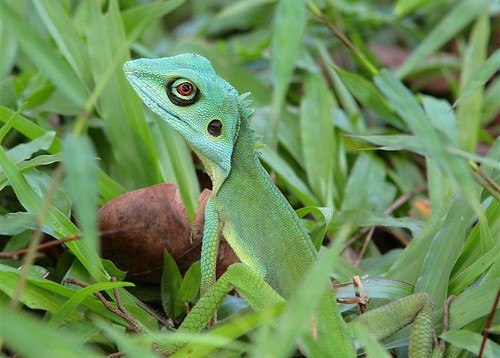
(Photos by hiker1974)
The green coloration clearly helps to provide camouflage.
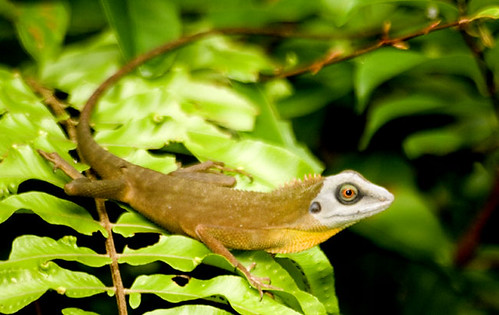
(Photo by Marcus)
However, when it feels threatened, the green crested lizard often turns dark brown.
There is still some overlap between the 2 species, and this is an interesting topic for future study. Is the green crested lizard, with its forest stronghold, adapting to the new ecological landscape and holding its own against the foreign invader? Or is it still in retreat, with the green crested lizards in our more urban parks and gardens representing remnants of populations doomed to eventually disappear?
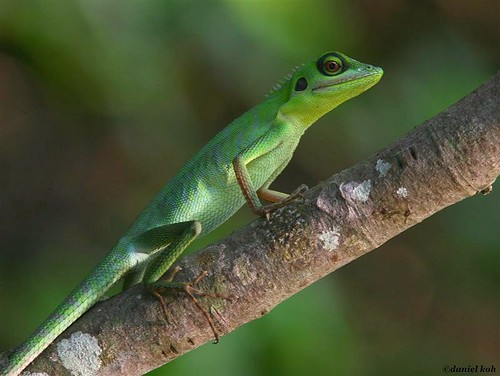
(Photo by hiker1974)
A third species of agamid, the earless agamid (Aphaniotis fusca), is restricted to the forests of the Central Nature Reserves.

(Photo by Marcus)
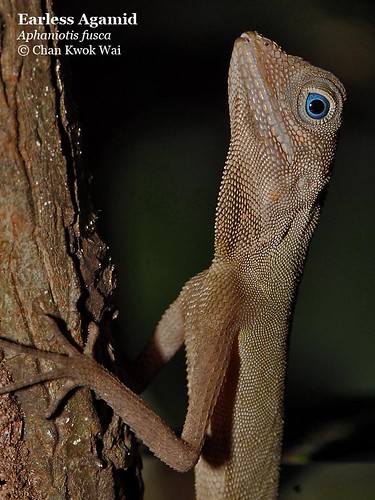
(Photo by kwokwai76)
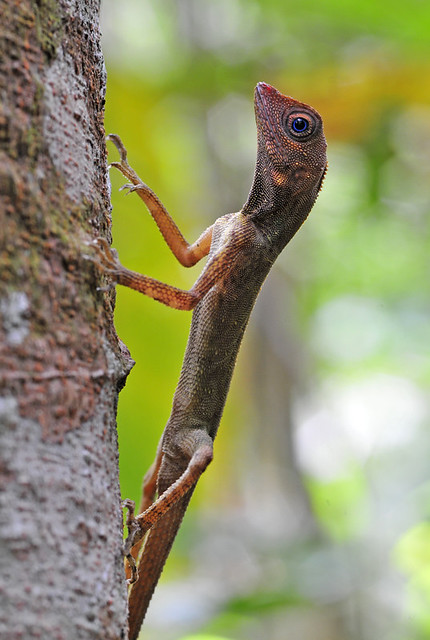
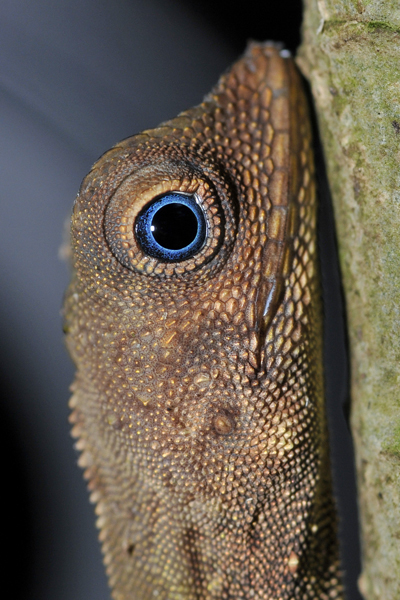
(Photos by Jacqueline)
As its name suggests, unlike other agamid lizards, which have a prominent tympanum (eardrum), this species has ears that are not so readily obvious.
2 additional species of agamids have supposedly been recorded in Singapore, although their presence here is considered doubtful.

Horned tree lizard (Acanthosaura armata); Penang;
(Photo by Sky and Yak)
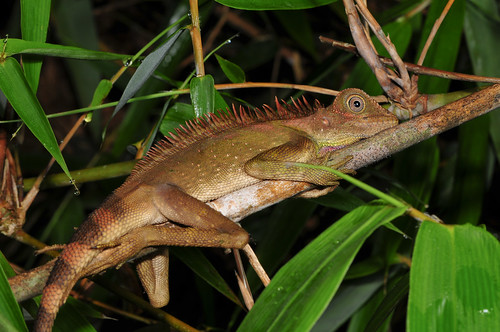
Bell's anglehead (Gonocephalus bellii), Pahang;
(Photo by Steven Wong (ATKR))
The horned tree lizard and Bell's anglehead are found in forests in Peninsular Malaysia, and have not been seen here in recent years. The old records were most probably based on mistakes in location or misidentification, though there is the remote possibility that these species were indeed once present here, but have since vanished due to the extensive deforestation that has seen the loss of more than approximately 95% of our original tropical forest cover.
The remaining 3 agamid species known to occur in Singapore are all flying dragons (Draco spp.), also called gliding lizards.

(Photo by Jacqueline)
The common flying dragon (Draco sumatranus) prefers open woodlands and forest edge, and has adapted to live in habitats subject to human disturbance, such as plantations and urban parks. It is widespread and common throughout Singapore, including several offshore islands.
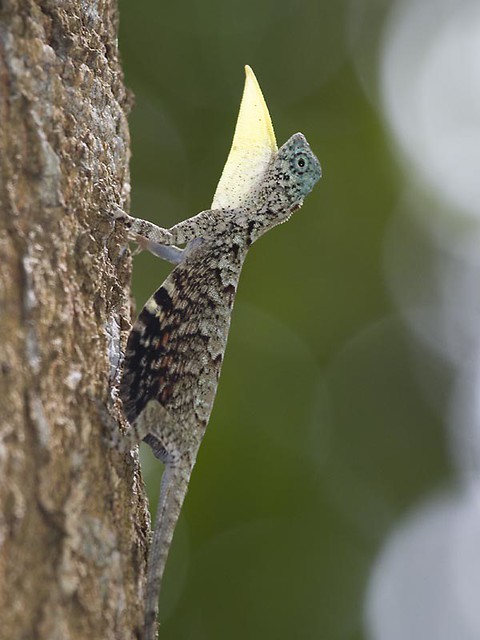
(Photo by kwokwai76)

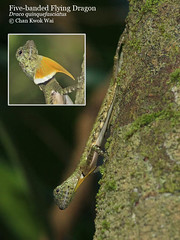
Left: Black-bearded flying dragon (Draco melanopogon);
(Photo by hisno)
Right: Five-banded flying dragon (Draco quinquefasciatus);
(Photo by kwokwai76)
On the other hand, the black-bearded flying dragon and five-banded flying dragon prefer mature forests, and are known only from the Central Nature Reserves. The five-banded flying dragon was first recorded here in Singapore only in 2001, a testament to the fact that despite their small size, our forests still conceal plenty of surprises.
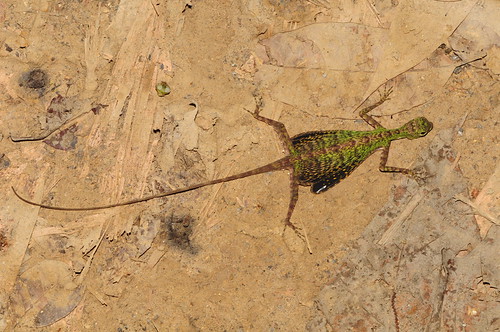
Black-bearded flying dragon;
(Photo by Steven Wong (ATKR))

Fringed flying dragon (Draco fimbriatus), Taman Negara;

Spotted flying dragon (Draco maculatus), Langkawi;
(Photos by Ulrich Manthey)
The local status of 2 additional species, the spotted flying dragon (Draco maculatus) and fringed flying dragon (Draco fimbriatus), is currently undetermined. Like the horned tree lizard and Bell's anglehead, there is always the possibility that the alleged presence of these species is the result of misidentifications or simply errors in record-keeping.
I wrote more about flying dragons in a recent post.
Compared to the forests of neighbouring countries, we seem to have relatively few agamid species. Perhaps it's simply the fact that small islands tend to have a lower capacity to support a multitude of different species. The extensive deforestation that occurred here is probably another factor; who knows what other agamid species may have vanished from our island, unnoticed? Still, our forests hold many surprises, and the recent discovery of the five-banded flying dragon attests to that.
Some of our agamids are quite successful, and have adapted to living in the disturbed habitats that characterise our public parks, gardens, and other urban green spaces. The changeable lizard is probably one of the most common lizards in Singapore, while the green crested lizard and common flying dragon are also widespread and can be found in areas with plenty of tree cover.
Our agamids may not be as majestic as say, the monitor lizards, but with their bizarre headgear and even aerial capabilities, they are truly impressive miniature dragons.